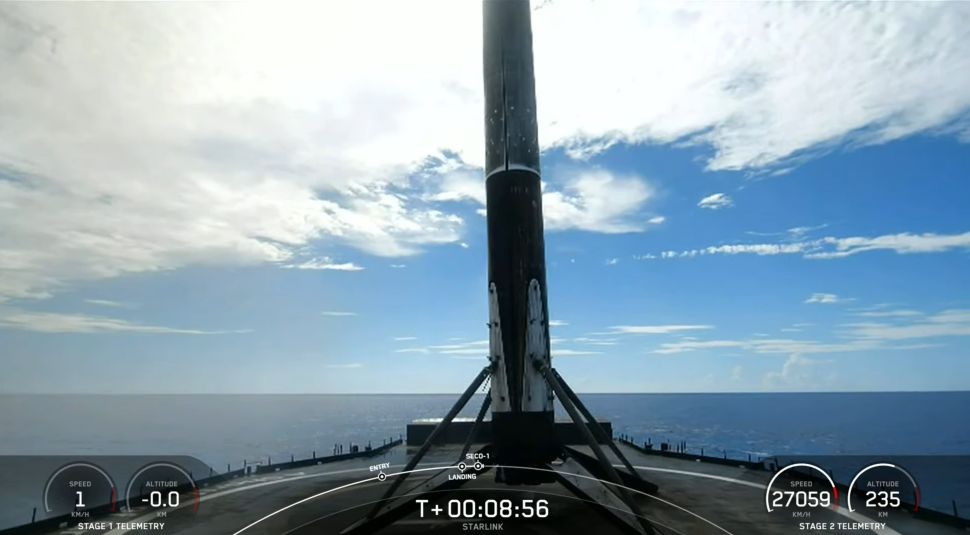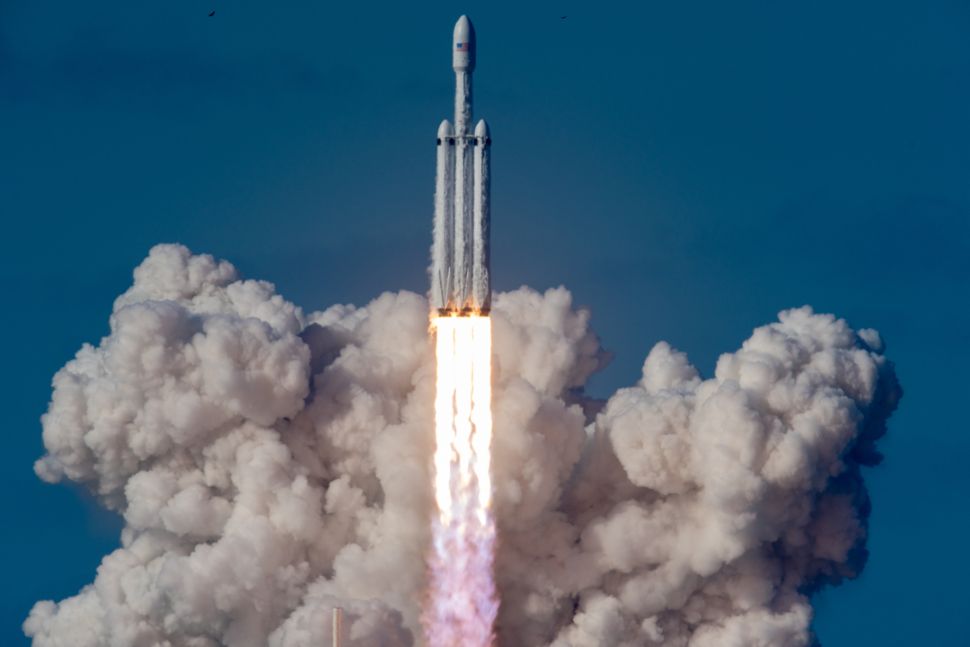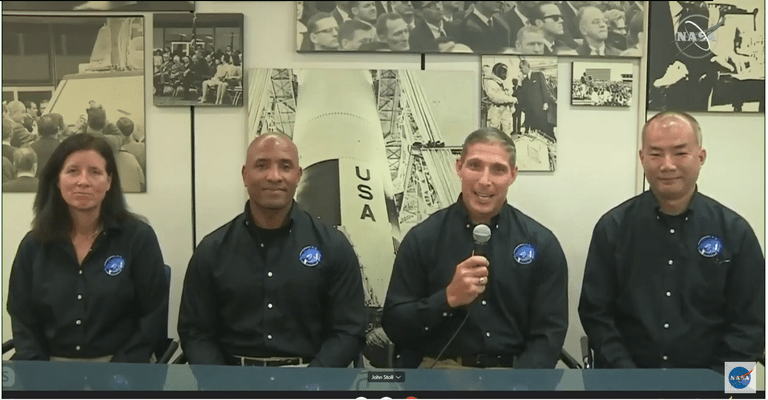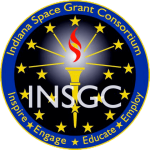SpaceX launches 53 Starlink satellites, lands Falcon 9 on droneship
July 24th, 2022
It was SpaceX's 33rd launch of 2022.
SpaceX launched a batch of Starlink satellites on Sunday (July 24) in what was the fifth launch for the program in July alone, and the company's 33rd launch of 2022.
SpaceX launched 53 Starlink internet satellites loaded aboard the Falcon 9 rocket that lifted off at 9:38 a.m. EDT (1338 GMT) from the Kennedy Space Center (KSC) in Florida.
At roughly eight minutes and 45 seconds after liftoff, the Falcon 9's first stage made a successful landing on the droneship A Shortfall of Gravitas stationed nearby in the Atlantic Ocean.
This Starlink launch follows a successful effort from Vandenberg Space Force Base in California Friday (July 22).
That blastoff brought 46 Starlink satellites to orbit, and the rocket's first stage softly touched down on a drone ship in the Pacific Ocean 8.5 minutes after launch. It was the second attempt to launch Starlink Group 3-2 to orbit following an abort induced by the Falcon 9 rocket at T-46 seconds on Thursday (July 21).
SpaceX's last Starlink launch from the east coast took place about a week ago on Sunday (July 17), from Cape Canaveral Space Force Station just down the road from KSC.
Starlink, the satellite Internet service from SpaceX, includes roughly 2,900 Starlink satellites(opens in new tab) launched to date. Starlink Group 4-25 adds on to previous launches this month from both the west and east coasts of the United States.
The company is working to amp up service quickly. It has regulatory approval to put at least 12,000 Starlink in orbit and is asking for an international regulator to loft another 30,000 satellites after that.

AX-1: Returns to Earth
After 17 days in space, Dragon and Axiom Space’s Ax-1 astronauts, Michael López-Alegría, Larry Connor, Eytan Stibbe, and Mark Pathy returned to Earth, splashing down off the coast of Florida at 1:06 p.m. ET on Monday, April 25.
Ax-1 was Axiom Space’s first all-private astronaut mission to the International Space Station.
You can watch a video of this launch at the link below:

MAKING HUMANITY MULTIPLANETARY
Building on the achievements of Falcon 9 and Falcon Heavy, SpaceX is working on a next generation of fully reusable launch vehicles that will be the most powerful ever built, capable of carrying humans to Mars and other destinations in the solar system.

So What Happens Next?
On Sunday, May 9 at 2:42 a.m. EDT, Falcon 9 launched 60 Starlink satellites from Space Launch Complex 40 (SLC-40) at Cape Canaveral Space Force Station in Florida. After stage separation, Falcon 9’s first stage returned to Earth and landed on the “Just Read the Instructions” droneship.
SpaceX will launch Astrobotic lander to the moon with NASA's ice-sniffing VIPER rover
April 14th, 2021
SpaceX's Falcon Heavy rocket — the same booster type that once sent the "Starman" mannequin to space in a Tesla Roadster — will send the Volatiles Investigating Polar Exploration Rover (VIPER) to the moon, on private company Astrobotic's lunar landing system.
Astrobotic's contract with NASA required the Pennsylvania-based company to independently select a launch contractor, and it chose SpaceX through a competitive procurement.
As with previous Falcon Heavy missions, SpaceX will launch VIPER from Launch Complex 39A at NASA's Kennedy Space Center near Orlando, Florida — a longtime launching location of moon missions, including the Apollo missions between 1969 and 1972.
VIPER is a key element of NASA's long-term plans to plant humans on the moon later in the decade — as soon as 2024 if the Donald Trump-era deadline remains under the new Joe Biden presidential administration. The NASA Artemis program will see crews of humans working alongside robotics to explore the moon and its resources, using NASA's Commercial Lunar Payload Services (CLPS) program.
Key among the Artemis program's goals is to learn how to live off the moon sustainably, potentially using resources such as lunar water ice at the moon's south pole to help astronauts and machinery function adequately for longer missions on the lunar surface. Humans last visited the moon during the Apollo missions, only staying for a few days at a time and bringing everything they needed from Earth.
August 7th, 2020
Now that the test mission has ended—and has largely been hailed as a success—NASA and SpaceX are busily planning for the next mission: Crew-1.
"What we just saw is the beginning of what will be a whole lot more activity in the future," NASA Administrator Jim Bridenstine said during a post-splashdown briefing on August 3.
The Crew-1 mission will mark the first operational Commercial Crew mission. The $2.6 billion contract SpaceX signed with NASA in 2014 stipulates that the company will fly a total of six missions to the International Space Station (ISS). Crew-1 will be the first in this series of flights.
The Commercial Crew program was developed to end NASA's reliance on expensive seats aboard Russia's Soyuz capsule, which cost as much as $90 million a head. A ride on SpaceX's Crew Dragon—and Boeing's Starliner CST-100 spacecraft—is estimated to be at least $30 million cheaper.
The Crew-1 mission launch is currently scheduled for late September. This time, four astronauts—NASA's Shannon Walker, Victor Glover, and Michael Hopkins, as well as SpaceX's first international partner, JAXA astronaut Soichi Noguci—will conduct a six-month mission aboard the ISS. They'll continue to maintain the space station, conduct a series of spacewalks, and perform a number of important experiments.

The Crew-1 astronauts have been training at SpaceX's Hawthorne, California facility, familiarizing themselves with their suits, their capsule, and those futuristic control panels. The Crew-1 capsule, which has been undergoing a series of tests at Hawthorne, will ship out to Florida either this week or sometime next week.
‘It came alive:’ NASA astronauts describe experiencing splashdown in SpaceX Dragon
August 7th, 2020
"Parachute deploy felt like 'getting hit in the back of the chair with a baseball bat"
NASA astronauts Doug Hurley and Bob Behnken described in detail what it felt like and sounded like when SpaceX’s spacecraft came roaring back down to Earth for a successful splash down in the Gulf of Mexico over the weekend.
The astronauts said they were surprised by how similar the experience was to what SpaceX had prepared them for.
The astronauts answered questions from NASA’s Johnson Space Center on Tuesday for the first time since they landed back on their home planet.
Hurley and Behnken launched on the SpaceX Dragon capsule, nicknamed Endeavour, from Kennedy Space Center on May 30, arriving on the International Space Station the next day. The launch marked the first human spaceflight from Florida’s coast in nearly nine years.
After more than two months in space, the duo journeyed back to Earth in Dragon Endeavour in about 19 hours, sleeping overnight in the spacecraft before the splashdown.
The Falcon 9 carried a Crew Dragon capsule, which was scheduled to rendezvous with the International Space Station on Sunday morning.
Aboard are two veterans of the astronauts corps, Robert L. Behnken and Douglas O. Hurley. Each is married to another astronaut — Mr. Behnken to Megan McArthur and Mr. Hurley to Karen Nyberg. NASA selected the two men along with a group of their colleagues to be the first customers of space capsules built by private companies.

